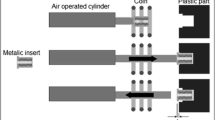Abstract
With an increased demand for comfortable and aesthetically pleasing automobile interiors, fabric seat covers are being used more widely. Previously, covers were manufactured using adhesives attached to a molding and covered with a skin layer. However, this process releases Volatile organic compounds (VOC), pollutes the air inside the automobile, and leads to peel-strength-related problems. This study examines a multi-component injection molding process that uses residual heat during injection molding to glue the skin layer to the molding, employed in seat-backboard manufacturing. Hence, the VOC emission problem is overcome as adhesives are not employed. To obtain enhanced peel strength the optimal skin material is selected using surface-adhesion length and material peel-strength measurements. The response surface design method is utilized with a design-of-experiments method to determine the process variables that maximize the peel strength for the selected materials. The process variable selection is then confirmed via additional experiments. It is expected that the problems related to VOC emissions and peel strength, which limit current seat-backboard manufacturing techniques, can be resolved through application of the optimal conditions identified in this study to a multi-component injection molding process.
Similar content being viewed by others
References
M. Hajiri, H. Kawai and S. Yoshida, Vehicle interior member, United State Patent 20,120,001,445 Issued, Jan. 5 (2012).
T. Yoshida and I. Matsunaga, A case study on identification of airborne organic compounds and time courses of their concentrations in the cabin of a new car for private use, Environment International, 32 (1) (2006) 58–79.
Y. C. Chien, Variations in amounts and potential sources of volatile organic chemicals in new cars, Science of The Total Environment, 382 (2–3) (2007) 228–239.
H. S. Lee, Y. G. Yoo and T. A. Kim, Film insert molding of automotive door grip using injection-compression molding, Trans. Korean Soc. Mech. Eng. A, 38 (7) (2014) 771–777.
S. K. Hong, I. K. Min, J. J. Kang and K. H. Yoon, Numerical prediction of process window for injection-compression molding of 7-inch LGP, Transcactions of Materials Processing, 20 (1) (2011) 5–10.
L. M. Galantucci and R. Spina, Evaluation of filling conditions of injection moulding by integrating numerical simulations and experimental tests, Journal of Materials Processing Technology, 141 (2003) 266–275.
A. Ameli, M. Nofar, D. Jahani, G. Rizvi and C. B. Park, Development of high void fraction polylactide composite foams using injection molding: Crystallization and foaming behaviors, Chemical Engineering Journal, 262 (2015) 78–87.
J. Javorsky, M. Franchetti and H. Zhang, Determining the optimal parameters of bonding polyvinylchloride to stainless steel in automotive applications with the use of full factorial design of experiment, CIRP Journal of Manufacturing Science and Technology, 7 (2014) 151–158.
M. Kavitha, R. Subramanian, K. S. Vinoth, R. Narayanan, G. Venkatesh and N. Esakkiraja, Optimization of process parameters for solution combustion synthesis of Strontium substituted Hydroxyapatite nanocrystals using Design of experiments approach, Powder Technology, 271 (2015) 167–181.
M. Oh, M. K. Lee and N. Kim, Robust design of rollformed slide rail using response surface method, J. of Mechanical Science and Technology, 24 (12) (2010) 2545–2553.
R. H. Myers, D. C. Montgomery and C. M. Anderson-Cook, Response surface methodology, Fourth Ed., John Wiley & Sons, USA (2016).
P. K. Singh1, S. D. Kumar, D. Patel1 and S. B. Prasad, Optimization of vibratory welding process parameters using response surface methodology, Journal of Mechanical Science and Technology, 31 (5) (2017) 2487–2495.
E. Njuhovic, A. Witt, M. Kempf, F. Wolff-Fabris, S. Glöde and V. Altstädt, Influence of the composite surface structure on the peel strength of metallized carbon fibre-reinforced epoxy, Surface and Coatings Technology, 232 (15) (2013) 319–325.
C. Kovalchick, A. Molinari and G. Ravichandran, An experimental investigation of the stability of peeling for adhesive tapes, Mechanics of Materials, 66 (2013) 69–78.
S. Yi, Y. Su, B. Qi, Z. Su and Y. Wan, Application of response surface methodology and central composite rotatable design in optimizing the preparation conditions of vinyltriethoxysilane modified silicalite/polydmethylsiloxane hybrid pervaporation membranes, Separation and Purification Technology, 71 (2) (2010) 252–262.
Author information
Authors and Affiliations
Corresponding author
Additional information
Recommended by Associate Editor Jaewook Lee
Youngshin Kim received her M.S. and Ph.D. from the School of Mechanical Engineering of Kongju National University, in 2010 and 2016, respectively. Her research interests include process techniques of vacuum glazing and process optimization techniques.
Euysik Jeon received his M.S. and Ph.D. from the School of Precision Mechanical Engineering of Hanyang University, in 1987 and 1995, respectively. He is currently a Professor in the Department of Mechanical and Automotive Engineering, Kongju National University. His research interests include process optimization techniques, structural design, and engineering.
Deok Rae Kim completed Graduate School at Kongju National University in 2015. Currently, he is working as a Research Director at Yongsan Co., Ltd., a company specializing in auto parts.
Rights and permissions
About this article
Cite this article
Kim, Y.S., Jeon, E.S. & Kim, D.R. Optimization of process variables for improvement of seat-backboard peel strength using response surface design method. J Mech Sci Technol 31, 5915–5920 (2017). https://doi.org/10.1007/s12206-017-1135-8
Received:
Revised:
Accepted:
Published:
Issue Date:
DOI: https://doi.org/10.1007/s12206-017-1135-8




